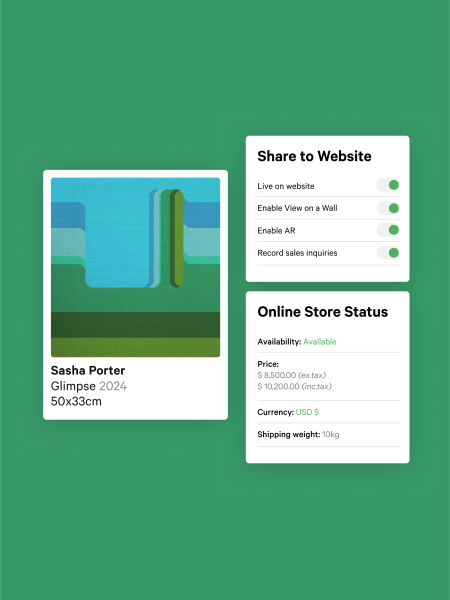Following the publication of the Art Basel and UBS Global Art Market Report 2024, Artlogic brought together leading voices from the art market to expand upon its findings, and draw out key takeaways for dealers.
Hearing from: Dr. Clare McAndrew, Cultural Economist, Arts Economics; Maureen Bray, Executive Director, the Art Dealers Association of America (ADAA); and Josh Baer, Founder, The Baer Faxt (podcast and newswire), the discussion focussed on the importance of nurturing relationships with collectors, adapting to an increasingly omnichannel art market, and the value of placing your own sales data at the heart of your optimization strategy.
Read on for the key takeaways from the virtual event.
Watch the webinar on-demand here
1. Nurture relationships with your existing collectors
The Art Basel and UBS report found that maintaining relationships with collectors was the second most significant challenge (36%) dealers faced in 2023/24. According to Bray, “building your client base is important, but clients are not human ATMs. They need to have a relationship as you help them build their collection.” She says that you should be “more interested in turning that buyer into a collector”, because the energy you spend nurturing these relationships is “important for the gallery's longevity.”
But what does nurturing look like? Bray says you should consider how (not just how often), you talk to your clients: “Spend more time asking the clients about what they need; about what they would prefer in a relationship with a gallery; about what’s meaningful to them: I think that is critical to maintaining longer relationships with clients.”

“Less email, more phone calls…”
Josh Baer agrees: “I say every year: less email, more phone calls… The days of sitting at your computer waiting for people to say they want something are gone.” And Dr Clare McAndrew urges dealers not to become consumed by the transactional nature of the deal at the expense of genuine connections with buyers: “It is such a relationship-based service industry. I know it’s based on the transactions we do with objects, but relationships are so important.”
2. In-person experiences are even more important as online sales grow
As online art sales grow, the value of in-person discovery and sales channels has never been greater. McAndrew explains: “the gallery is still key. 44% of your sales were reported as from an in-person visit to the gallery or premises.” And, this is especially true if you’re looking to connect with new collectors, with the report finding that art fairs were the most likely place for galleries to meet new buyers (30%), followed by walk-ins at the gallery (21%).
“The gallery is still key.”
Baer notes that “during Covid, people were discovering and buying online, led by what looked good on their phones or laptops, which drove traffic to more figurative, less abstract art. Now, there’s a desire to get out and see and smell the art.” He adds that you should think about the types of works and artists that succeed in-person. But, ultimately, “the quality of the work”, is always paramount.

“Don't sit in your office hoping for the best.”
Re-emphasising this point, Bear shared a candid anecdote: a conversation with prominent art dealer David Zwirner where they hypothetically loaded a U-haul truck with art and drove up the east coast of the US to visit collectors. On reflection, Bear encouraged dealers to “get in a truck with your art handler and show the art, don't sit in your office hoping for the best.”
3. Omnichannel is the future of the art market
Omnichannel is the future. On this shift, McAndrew says: “There’s been a permanent change in the way business is being done. A lot of businesses are working harder than ever on lots of different channels. Buyers are keen to attend events again, so people are pedaling away at fairs, but they’re also pursuing digital strategies.”So, how should dealers adapt? The art market is inherently omnichannel, but this is more by accident than design. The key for dealers is to focus on purposeful optimization for omnichannel: streamlining the buyer journey across disparate channels to deliver maximum engagement.
In some ways, this has never been easier. Of the growth in online sales, the biggest increase has come through dealers’ own online channels and websites, increasing from 12% in 2022 to 20% in 2023. This is great for omnichannel optimization, as it gives you maximum control over the touchpoints you have with buyers, and over the data produced by these interactions and sales.

“All online platforms should really be seen as tools”
Bray says that even businesses with limited resources should explore how to adopt an omnichannel approach: “I think that all online platforms should really be seen as tools, and you have to do passive outreach for the most part. You have to look at the amount of time you're spending on your passive outreach from a labor standpoint versus the ROI.”
4. Put your own sales data at the heart of your optimization strategy
Global reports are a fantastic resource for dealers and gallerists, but they’re mostly useful for broad trends and benchmarking. Bray explains: “Reports help you understand the market at a macro level, but your sales records will tell you about your current position.”Understanding your historic sales data, and using that as a basis for effective decision making, should be at the heart of your optimization strategy. Bray continues: “The answers are in your own data. Look at your sales trends for the last 2-3 years: who'd you sell it to and at what level? Do that analysis, know what did well and what didn't, and use that as the basis from which you make decisions.”

“The focus should always be on profitability rather than just sales.”
It’s also important to understand your most critical metrics. As McAndrew says: “The main takeaway from the last couple of years doing the research was the focus should always be on profitability rather than just sales.” For truly effective optimization, personalize the data that you collect to your business goals.
McAndrew adds: “It’s extra important to do a cost-benefit analysis of where you’re deriving your most profitable sales from. But measuring the value of a fair is not just the sales but what it generates down the line.”
Watch the full webinar on-demand
Finally, how Artlogic helps
Artlogic helps galleries of all sizes achieve omnichannel success. With the Arlogic App, powerful sales and marketing tools, plus Artlogic Pay, you can create a diverse buying experience tailored to the needs of the individual collector.
And, when it comes to developing a real-time understanding of your own data, Artlogic’s data and reporting function transforms your sales data into critical insights, allowing you to spot trends, seize opportunities and optimize your strategy.







